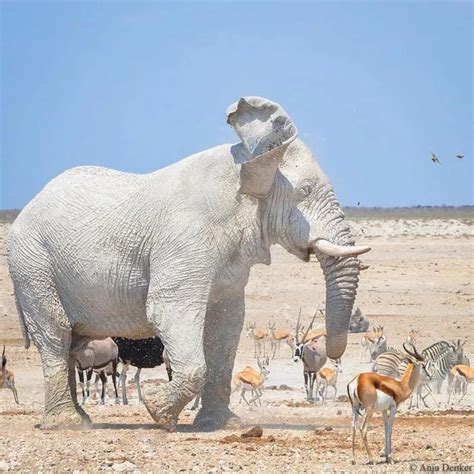
A rare, pale-skinned elephant, affectionately dubbed a “ghost elephant” due to its unusual coloration, has been spotted in Kenya’s Tsavo National Park for the first time in several years, prompting cautious optimism among conservationists about the effectiveness of ongoing protection efforts. The sighting offers a potential sign that these unique animals, threatened by poaching and habitat loss, are persisting under current conservation strategies.
The elephant, whose light pigmentation is likely caused by a genetic condition called leucism, was photographed and filmed by tour guides and park visitors, generating significant buzz online and renewed interest in the plight of these vulnerable creatures. Leucism, unlike albinism, results in reduced pigmentation across the animal’s body, but not a complete absence of color. This means the elephant retains some pigment, particularly in its eyes, distinguishing it from an albino elephant, which would have pink eyes.
The Tsavo Trust, a conservation organization dedicated to protecting elephants in the Tsavo ecosystem, confirmed the sighting and expressed cautious optimism. While the exact number of leucistic elephants in Tsavo is unknown, sightings are extremely rare, making each appearance a significant event. “The sighting of this ‘ghost elephant’ is a cause for celebration and renewed dedication to conservation efforts,” stated a representative from the Tsavo Trust. “It reminds us of the unique biodiversity we are striving to protect and the importance of our work in combating poaching and habitat destruction.”
The Tsavo ecosystem, encompassing Tsavo East and Tsavo West National Parks, is one of the largest protected wildlife areas in Kenya and a crucial sanctuary for elephants. It has historically been a hotspot for poaching, driven by the illegal ivory trade, but increased anti-poaching patrols, community engagement programs, and stricter law enforcement have significantly reduced poaching incidents in recent years.
The “ghost elephant’s” reappearance raises crucial questions about the long-term viability of leucistic elephants and the effectiveness of current conservation strategies in ensuring their survival. While the sighting is encouraging, experts caution that leucistic elephants may face unique challenges, including increased susceptibility to sunburn and potentially greater visibility to predators, particularly when young.
Further research and monitoring are needed to better understand the genetic makeup of these elephants, their specific ecological needs, and the potential threats they face. The Tsavo Trust and other conservation organizations are working to expand their research efforts to include genetic studies and population monitoring programs specifically targeted at identifying and tracking leucistic elephants.
The resurgence of this rare elephant underscores the vital role of protected areas like Tsavo National Park in safeguarding vulnerable species. However, it also highlights the ongoing need for sustained conservation efforts, including combating poaching, mitigating human-wildlife conflict, and addressing habitat loss, to ensure the long-term survival of elephants and other wildlife in the region.
Additional Details and Context:
Leucism in elephants is a rare genetic condition that results in reduced pigmentation. It’s important to distinguish it from albinism, which is a complete absence of melanin. Leucistic animals have reduced pigment, but still have some coloration. In elephants, this typically manifests as a pale, almost pinkish-grey skin tone.
The Tsavo ecosystem is a vital habitat for a large population of elephants. The Tsavo East and Tsavo West National Parks combine to form one of the largest national parks in the world, providing a vast area for elephants to roam and find food and water. The ecosystem faces various threats, including poaching, habitat loss due to agricultural expansion and deforestation, and human-wildlife conflict, which arises when elephants raid crops or damage property.
The Tsavo Trust plays a critical role in protecting elephants in the Tsavo ecosystem. The organization conducts anti-poaching patrols, monitors elephant populations, works with local communities to mitigate human-wildlife conflict, and supports research on elephant behavior and ecology. They utilize aerial surveillance, ground patrols, and intelligence gathering to combat poaching and protect elephants from other threats.
The poaching crisis of the 1970s and 1980s decimated elephant populations across Africa, including in Tsavo. However, concerted conservation efforts have led to a significant decline in poaching in recent years. Increased anti-poaching patrols, stricter law enforcement, and community engagement programs have all contributed to this success. However, poaching remains a threat, and continued vigilance is essential to prevent a resurgence.
Human-wildlife conflict is a significant challenge in areas where elephants and people share the same landscape. Elephants can damage crops, destroy property, and even kill people, leading to retaliatory killings of elephants. The Tsavo Trust works with local communities to implement strategies to mitigate human-wildlife conflict, such as building electric fences around farms, providing compensation for crop damage, and educating communities about elephant behavior and conservation.
The sighting of the “ghost elephant” provides an opportunity to raise awareness about the plight of elephants and the importance of conservation. The unusual appearance of the elephant makes it a compelling symbol of the need to protect these magnificent creatures and their habitat. The Tsavo Trust and other conservation organizations are using the sighting to generate support for their work and to encourage people to get involved in elephant conservation.
Genetic studies of leucistic elephants could provide valuable insights into the genetic basis of the condition and its potential impact on elephant survival. These studies could help to identify other leucistic elephants in the population and to assess their genetic diversity. This information could be used to develop conservation strategies that are tailored to the specific needs of leucistic elephants.
The long-term survival of leucistic elephants depends on a range of factors, including their ability to adapt to their environment, their susceptibility to disease, and the level of protection they receive from poaching and other threats. Continued monitoring of the “ghost elephant” and other leucistic elephants is essential to assess their health and well-being and to identify any potential problems.
The conservation of elephants requires a collaborative effort involving governments, conservation organizations, local communities, and individuals. By working together, we can ensure that elephants continue to thrive in the Tsavo ecosystem and other parts of Africa. Supporting conservation organizations like the Tsavo Trust, educating others about the importance of elephant conservation, and making responsible choices as consumers can all contribute to the long-term survival of elephants.
The news of the “ghost elephant” comes at a time when elephant populations in some parts of Africa are facing increasing pressure from habitat loss and poaching. The success of conservation efforts in Tsavo provides a model for other regions to follow. By implementing similar strategies, we can protect elephants and other wildlife in other parts of Africa and around the world.
The sighting of the “ghost elephant” is a reminder of the beauty and wonder of the natural world. It underscores the importance of protecting biodiversity and preserving our planet for future generations. By working together, we can ensure that future generations will have the opportunity to see these magnificent creatures in their natural habitat.
The continued presence and now renewed sighting of the leucistic elephant serve as an indicator of ecosystem health and the effectiveness of the implemented conservation measures. Regular monitoring and protection programs are essential to ensure the long-term survival of this rare and special animal. The future of these elephants lies in continued conservation efforts, community involvement, and ongoing research to understand and address the challenges they face.
Detailed Analysis of Conservation Efforts:
The Tsavo ecosystem has witnessed significant improvements in elephant conservation due to multifaceted strategies:
-
Anti-Poaching Measures: Increased patrols by rangers, use of advanced technology such as drones and satellite monitoring, and enhanced intelligence gathering have been crucial in curbing poaching activities. The Tsavo Trust’s dedicated anti-poaching units work tirelessly to protect elephants from poachers, removing snares, and apprehending those involved in illegal activities.
-
Community Engagement: Engaging local communities in conservation efforts is vital for long-term success. The Tsavo Trust collaborates with communities by providing education programs, creating employment opportunities, and supporting sustainable development initiatives. This fosters a sense of ownership and encourages communities to actively participate in protecting wildlife.
-
Habitat Protection: Protecting and restoring elephant habitats is essential. The Tsavo Trust works to combat deforestation, prevent encroachment on protected areas, and promote sustainable land management practices. This ensures that elephants have access to adequate food and water resources.
-
Human-Wildlife Conflict Mitigation: Implementing measures to reduce human-wildlife conflict is crucial for preventing retaliatory killings of elephants. The Tsavo Trust supports the construction of electric fences around farms, provides compensation for crop damage, and educates communities about elephant behavior and conflict resolution techniques.
-
Monitoring and Research: Conducting regular monitoring and research is essential for understanding elephant populations, their movements, and their ecological needs. The Tsavo Trust uses aerial surveys, ground patrols, and GPS tracking to monitor elephant populations and gather data on their behavior and habitat use. This information is used to inform conservation strategies and to assess the effectiveness of conservation efforts.
-
Law Enforcement: Strengthening law enforcement is crucial for deterring poaching and other illegal activities. The Tsavo Trust works with law enforcement agencies to apprehend and prosecute poachers and other wildlife criminals. Stricter penalties for wildlife crimes send a strong message that such activities will not be tolerated.
Challenges and Future Directions:
Despite the progress made in elephant conservation, several challenges remain:
-
Climate Change: Climate change is exacerbating drought conditions in the Tsavo ecosystem, leading to increased competition for water and food resources. This can increase human-wildlife conflict and make elephants more vulnerable to poaching.
-
Habitat Loss: Habitat loss due to agricultural expansion, deforestation, and infrastructure development continues to threaten elephant populations. Protecting and restoring elephant habitats is essential for ensuring their long-term survival.
-
Human Population Growth: Rapid human population growth is putting increasing pressure on natural resources, including elephant habitats. Managing human population growth and promoting sustainable development are crucial for reducing the impact on elephant populations.
-
Illegal Wildlife Trade: The illegal wildlife trade continues to drive poaching and threaten elephant populations. Strengthening international cooperation and combating the illegal wildlife trade are essential for protecting elephants.
To address these challenges, future conservation efforts should focus on:
-
Climate Change Adaptation: Implementing measures to help elephants adapt to climate change, such as providing alternative water sources and restoring degraded habitats.
-
Sustainable Land Management: Promoting sustainable land management practices that balance human needs with the needs of wildlife.
-
Community Empowerment: Empowering local communities to participate in conservation efforts and to benefit from wildlife tourism.
-
International Collaboration: Strengthening international cooperation to combat the illegal wildlife trade and to support elephant conservation efforts.
-
Increased Funding: Increasing funding for elephant conservation to support research, monitoring, anti-poaching patrols, and community engagement programs.
Frequently Asked Questions (FAQs):
Q1: What is leucism and how does it affect elephants?
Leucism is a genetic condition that causes reduced pigmentation in an animal. Unlike albinism, which results in a complete absence of melanin, leucism leads to a partial loss of pigment. In elephants, this often manifests as a pale, almost pinkish-grey skin tone. While the exact impact on elephants is still being studied, leucism might increase susceptibility to sunburn and potentially make them more visible to predators, especially when they are young. However, this is based on general understanding of leucism in animals and specific studies for elephants are yet to be concluded.
Q2: Where was this “ghost elephant” sighted and why is that location important?
The “ghost elephant” was sighted in Tsavo National Park, located within the Tsavo ecosystem in Kenya. The Tsavo ecosystem is one of the largest protected wildlife areas in Kenya and a crucial sanctuary for elephants. It has historically been a hotspot for poaching, but increased anti-poaching efforts and conservation strategies have helped reduce poaching incidents in recent years. The area’s size and protection status make it a vital refuge for elephants and other wildlife.
Q3: What is the Tsavo Trust and what role does it play in elephant conservation?
The Tsavo Trust is a conservation organization dedicated to protecting elephants and other wildlife in the Tsavo ecosystem. The organization conducts anti-poaching patrols, monitors elephant populations, works with local communities to mitigate human-wildlife conflict, and supports research on elephant behavior and ecology. Their efforts are essential in combating poaching, protecting elephant habitats, and promoting coexistence between humans and wildlife. They also engage in aerial surveillance and intelligence gathering.
Q4: Is the sighting of the “ghost elephant” a sign that conservation efforts are working?
The sighting of the “ghost elephant” is indeed a promising sign that conservation efforts in Tsavo are having a positive impact. It suggests that even rare and vulnerable animals are persisting under current protection strategies. However, experts caution that continued monitoring and research are needed to fully assess the long-term viability of leucistic elephants and to ensure that conservation strategies are effectively addressing their specific needs. The Tsavo Trust considers this sighting as a ’cause for celebration and renewed dedication to conservation efforts.’
Q5: What can individuals do to support elephant conservation?
Individuals can support elephant conservation in several ways:
- Donate to conservation organizations: Supporting organizations like the Tsavo Trust helps fund their vital work in protecting elephants and their habitats.
- Raise awareness: Educate friends and family about the importance of elephant conservation and the threats they face.
- Support sustainable tourism: Choose tourism operators that prioritize responsible and ethical practices that benefit local communities and wildlife.
- Make informed consumer choices: Avoid buying ivory products or products that contribute to habitat destruction.
- Reduce your carbon footprint: Climate change poses a significant threat to elephants and their habitats, so reducing your carbon footprint can help mitigate this threat.
- Advocate for stronger conservation policies: Support policies that protect elephants and their habitats.
The rediscovery of the “ghost elephant” in Tsavo is more than just a remarkable sighting; it is a testament to the relentless efforts of conservationists and the enduring resilience of nature. This unique elephant, a symbol of the Tsavo ecosystem, represents the ongoing battle against poaching and habitat loss, a battle that demands continuous vigilance and collaboration. While the appearance of this leucistic individual offers a beacon of hope, it also calls for sustained investment in conservation, scientific research, and community engagement. Only through these combined efforts can we ensure a future where elephants, even those as rare and special as this “ghost,” thrive in their natural habitats for generations to come. This event shines a light on the importance of protected areas and reinforces the commitment needed to protect these majestic creatures from extinction. The “ghost elephant’s” story is a compelling reminder of the beauty and fragility of our natural world and the responsibility we share to safeguard it.









